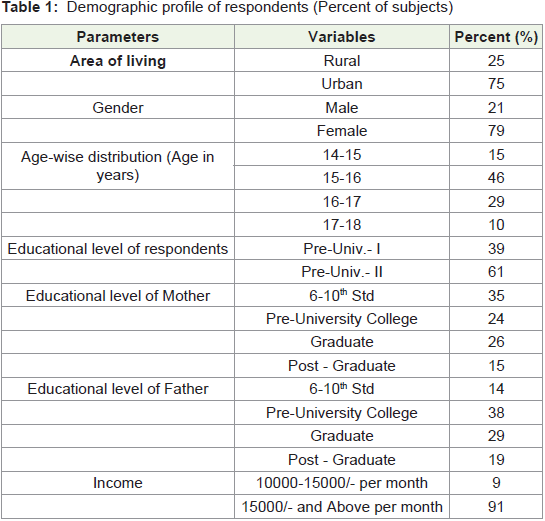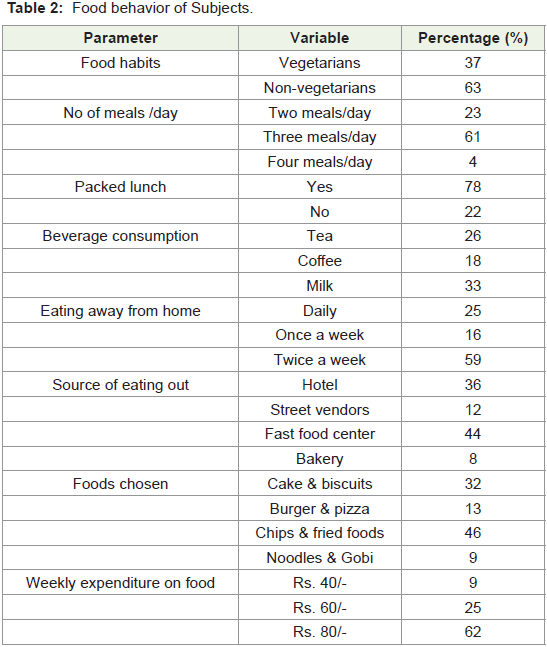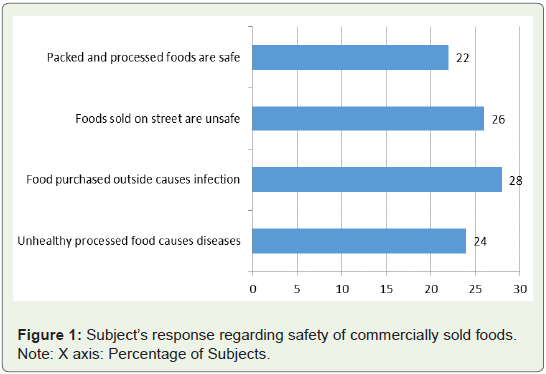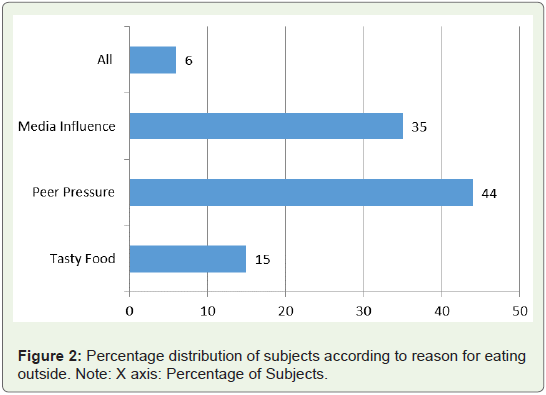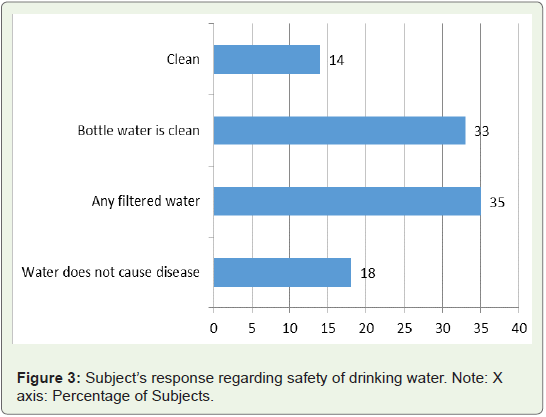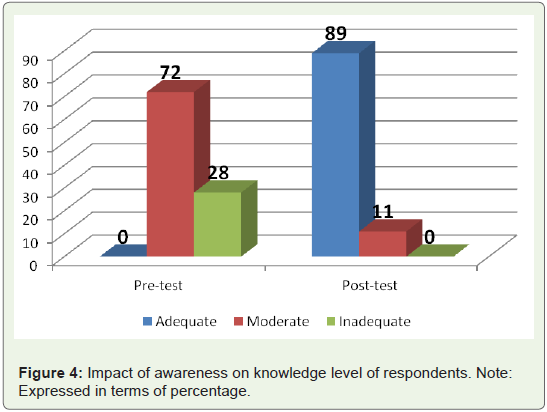Research Article
Impact of an Awareness Creation Programme on Consumption of Food Pattern among Adolescents
Hemalatha MS1*, Padmavathamma1, D’Souza SA1 and Prakash J2
1Department of Food Science and Nutrition, Karnataka State Open University, India
2Department of Food Science and Nutrition, University of Mysore, India
*Corresponding author: Hemalatha MS, Department of Food Science and Nutrition, University of Mysore, India; Email:
drmshemap@gmail.com
Article Information: Submission: 14/05/2021; Accepted: 16/06/2021; Published: 19/06/2021
Copyright: © 2021 Hemalatha MS, et al. This is an open access article distributed under the Creative Commons Attribution License,
which permits unrestricted use, distribution, and reproduction in any medium, provided the original work is properly cited.
Abstract
Adolescents are more prone to changes in lifestyles and food habits and they also impel for more opportunity to assert food choices and expand or narrow
healthy option. Hence, this research was planned to study the existing pattern of consuming unhealthy foods among adolescents and impact of an awareness
programme. The study was conducted at Father Muller School of Nursing, Mangalore and Shanthiniketan Pre-University College, Chikkaballapur on 100
subjects from each institute during their mid-term of academic year. Demographic profile, food habits and knowledge regarding hazards of junk foods and other
healthy habits were studied using a structured questionnaire. Nutrition intervention was carried out using powerpoint presentation, brochures in three sessions.
The study showed that 75% of subjects were from urban background with 46% belonging to middle adolescence age group (15-16 years). Education level of
parents on an average was above Pre-University level with family income more than Rs. 15,000/- per month. Food habits of the subjects showed that 37%
were vegetarian and 63% were non-vegetarian. Subjects were in the practice of carrying packed lunch; however, few subjects consumed food from outside
and spent around Rs. 80/- for junk foods on weekly basis. Peer pressure and media influence were the main reasons to consume food outside. Pre-test scores
showed that 72% of the subjects had moderate knowledge about junk foods and eating habits and post-test scores showed 89% of the subjects were able to
grasp adequate knowledge. The post-test scores were higher in comparison with pre-test scores, showing positive impact of education programme. The study
brings out the need to create awareness in adolescents regarding healthy eating habits.
Keywords
Junk foods; Food behavior; Education programme; Nutritional knowledge
Introduction
Adolescent period is defined as transition of human being from
childhood to adulthood involving physical, mental and emotional
change [1]. WHO defines adolescents as persons in the age group of
10 to 19 years [2]. In India, adolescent population is estimated to be
about 243 million [3]. The spurt out to adulthood gives rise to many
metabolic changes in the body making provision of high demands
for protein, fat, carbohydrate, minerals and vitamins, importantly
all the metabolisms are accelerated by release of hormones [4].
Adolescents are more prone to change in lifestyles and food habits
and they also impel for more opportunity to assert food choices and
expand or narrow healthy options [5]. In addition, adolescents also
exhibit unhealthy eating habits such as meal skipping and snacking
on fast foods [6,7]. A study reported that adolescent girls associated consumption of fast food with pleasure, friends, and independence,
while they associated consumption of healthy food with parents and
being at home [8]. These food behaviors may set in train unhealthy
eating trends for adult life [9] and contribute to a number of health
problems including overweight and obesity, metabolic syndrome,
diabetes and cancers [10]. These unhealthy food habits may lead
to deficiency disorders, and the prevalence of anemia is mentioned
to be 69% among adolescent girls [11]. Micronutrient deficiency
disorders in the adolescent phase results in growth retardation, low
immunity and impaired reproductive functions [12]. The deficiencies
may lead to stress and fatigue. Stress often results in the abuse of
tobacco and other habits like drug consumption [13]. Adolescents
dietary behaviors will be extended even after becoming adults and
establishing new households that are independent of their parents
and family [14]. Improvement of the food habits of adolescents is therefore one avenue to reduce the prevalence of these health
problems.
The rapid proliferation of multinational fast food companies in
the Indian food market and the influence of Western culture have
replaced traditional home cooked meals with ready-to-eat, processed
foods in urban Indian households [15] Junk food is the term given
to food that is high in calories but low in other nutritional contents
[16] Junk foods have no or very less nutritional value and irrespective
of the way they are marketed, they are not healthy to consume [17]
Peer pressure, parents’ dietary habits and media exposure influence
the dietary intake of this age group [18] The consumption of fast
foods has been increased around the world over last 50 years [19]
Foods such as French fries, burgers and chips, which constitutes huge
amount of fat and salt are harmful for health. Research has shown
that junk food consumption is linked to behavioral disorders [20].
Many people, especially children, suffer from ADHD (Attention
deficit hyperactive disorder) due to additives and added sugar in junk
food [21] A strong positive association has been reported between
fast food consumption and both weight gain and insulin resistance,
suggesting that fast food increases the risks of obesity and type 2
diabetes [22].
Nutrition education is the combination of educational strategies,
accompanied by environmental supports, designed to facilitate
voluntary adoptions of food choices and other food and nutrition
related behaviors conducive to health and well-being [23]. Nutrition
education is delivered through multiple venues and involves activities
at the individual, community and policy levels. The importance of
nutrition education as a means for improving the nutrition of the
community in the developing countries has been increasingly realized
during recent years [24]. National Nutrition Monitoring Bureau
(NNMB) reports only 14% of adolescent population are exposed to
nutrition education [25].
All the above prospects motivated in studying the impact of
nutrition education programme on consumption of unhealthy foods
in adolescents with the following objectives,
a. To assess the consumption pattern and knowledge level
regarding unhealthy processed foods
b. To create awareness regarding unhealthy foods through
nutrition education programme and assess the impact of the same.
Methods
Research Design and Sampling:
Food habit and lifestyle survey was conducted among adolescent
children from Father Muller School of Nursing, Mangalore and
Shanthiniketan Pre-University College, Chikkaballapur during their
mid-term of academic session. The sample was randomly chosen
according to the cluster by interviewing all students in selected
classes to obtain a sample in excess of the calculated sample size.
Accordingly, convenient sampling of 100 members was considered
for the study inclusive of both the genders. However, the percentages
of female subjects were more as they were more co-operative and
schedule was feasible. Initially, adolescents were informed of the
study and asked verbally for their consent to participate. Subjects with examining the clinical features and confirmation of no history of
any chronic disease and surgeries were considered for the study. The
considered subjects were given an informed to be signed by parents
orguardians, which included a brief explanation of the research
objectives and methodology, as well as the assurance that there would
be no identification of participants.Survey instrument:
A descriptive food questionnaire was designed by the researchers
to study the trends of fast food consumption. A face-to-face interview
questionnaire was performed with the respondents after defining
fast food and giving them an overview about the study. Questions
regarding vegetarianism, meal consumption patterns, food and
beverage intake, snacking practices, household food rules, home
food environment, secondary school nutrition curriculum, school
canteen, acquisition of food skills, exposure to media, consumerism,
family characteristics and demographics were included in the
Questionnaire. The questionnaire also investigated the trends of fast
food consumption.Development of questionnaires:
The descriptive questionnaire was developed to study the
demographic profile and food habits of adolescent children which
highlighted on vegetarianism, meal consumption patterns, food and
beverage intake, snacking practices, household food rules, home food
environment, school canteen, acquisition of food skills, exposure
to media, consumerism, family characteristics, dietary habits and
lifestyle. Face validity for the questionnaire was assessed by using a
pilot-tested group of 10 participants from the target population to
ensure that the questions are understandable. A face-to-face interview
questionnaire was performed with the respondents after defining
junk food and giving them an overview about the study.Intervention Programme:
Prior to the commencement of intervention programme,
the school authorities were given a brief oral introduction to the
survey procedures and nutrition education programme. Nutrition
education programme regarding the ill effects of unhealthy foods
was conducted using different modules like flash cards, Power Point
presentation and Brochures. Power point presentations included
pictorial as well as video representation for better understanding of
subjects. The intervention programme was repeated for every fifteen
days with different modules. It was started with awareness creating
through brochure, flash cards were distributed and later a powerpoint
presentation was done which included video representation also.Knowledge Test score:
Along with the descriptive food questionnaire, nutritional
knowledge test was designed by the researchers to study the
knowledge regarding the effects of junk food consumption of the
subjects. The test was provided in a printed sheet of 20 questions
which also included multiple choice questions. Each question carried
1 score, subjects scoring less than 7 were considered as inadequate
level of knowledge, accordingly, subjects scoring 7 and below 14
were considered moderate level of knowledge and above 13 were
considered as adequate level of knowledge. Then the knowledge tests
were expressed in percentage and tabulated.Data Analysis
Socio-demographic, diet, and nutritional knowledge levels of the
adolescents were collected and computed. The data were expressed in
the form of percentage. Table 1 shows the association of demographic
profile of subjects with educational level of parents and family
income. Table 2 shows the food habits, meal pattern and related to
family income and expenditure towards junk foods. Pre-nutritional knowledge were recorded and plotted in the graph. Comparison
between pre-test and post test scores were represented in the form
of graph.
Results and Discussion
Demographic profile of respondents:
Demographic profiles of subjects are represented in Table 1.
The study showed that 75% of subjects are from urban background.
Globalization and urbanization have greatly affected eating habits
and forced many people to consume fancy and high calorie fast foods
[26,27]. Female subjects were selected keeping view of availability and
co-operation and participated in larger number than male subjects. Of
the total participants, 46% belonged to middle adolescence age group
(15-16 years) as compared to 15% who belonged to early adolescence
age group (14-15 years) and 29% belonged to older adolescence age
group (16-17 years) and only 10% were from 17-18 years age group.
Few researchers in India have studied the similar age group regarding
junk food consumption [3,26,27]. Most of the subjects were studying
in II year PUC (Pre-University Course) while the remaining were in
I PUC of their Pre-University College. Education level of mothers
showed that more than 50% were educated up to Pre- University level,
however, the education level of fathers showed that more than 50%
were educated above Pre-University level. Researcher have worked on
parenting and report that mothers are more involved in childcare and
formal support than fathers, [28] accordingly, the adolescence food
habits will be monitored more by mothers than fathers although they
are more educated. Majority (91%) of the subject’s family income was
more than Rs. 15,000/- per month. Studies reveal that with increase
in income level contribution to the purchasing power parity exchange
rate is more [29].Food behavior of subjects:
Food behavior data of adolescents are presented in Table 2. Food
habits of the subjects showed that 37% were vegetarian and 63% were
non-vegetarian. A study conducted in rural parts of North India also
reported that 38% of adolescents were vegetarian and remaining
were non- vegetarian [30]. Most of the subjects (61%) followed 3
meal pattern, remaining followed 2 (23%) meal pattern and very few
subjects (4%) followed 4 meal pattern. Adolescent girls are said to
be the highest proportion of meal skippers [31]. Subjects were in the
practice of carrying packed lunch; however, few subjects consumed
food from outside. Dissimilarities were not observed in subjects
towards their liking for beverages, 33% of subjects consumed only
milk, whereas 26% consumed tea and remaining preferred coffee.
None of the subjects reported about consuming carbonated drinks,
however, a study conducted abroad reports carbonated soft drinks
were the main beverage usually consumed by adolescents (89%) but
other beverages such as coffee, tea, sweetened fruit drinks, or energy
drinks were rarely consumed [8]. More than 50% of the subjects had
the habit of consuming food outside twice a week; however, 25% of
the subjects had the habit of consuming food outside daily. Alfaris
et al [8] reported 52.8% of adolescent girls consumed outside food
twice a week which was higher compared to our study. Majority of
the source of food consumption outside was from fast-food centers.
Alfaris et al [8] revealed that source of food consumption outside was from restaurants, which could be due to lack of fast food centers. Food
choices of the subjects from outside were chips, fried foods followed
by cake, biscuits, burger, pizza, noodles and Gobi-manchurian(fried
spicy cauliflower dish). Cohen et al [32] indicated that 86% of girls
consumed nearly double the maximum recommended calories from
snack foods which included burgers, chicken nuggets, and pizza
averaging nearly four times per week. Sahu & Das [26] also revealed
that majority of adolescents consumed junk food such as bakery
products, chips, carbonated drinks infrequently. A significantly
higher rate of adolescent girls reported eating pizza (49.3%), followed
by french fries (29.6%) [8]. Younis & Eljamay [33] also reported 54%
of adolescents frequently consumed chips followed by French fries,
Pizza, fried chicken, hamburger and chocolate. A study conducted
in Kolkata city showed evidence of excess intakes of energy-dense,
nutrient-poor foods and inadequate intakes of nutrient-dense foods
by adolescents [27]. Around Rs. 80/- was spent by 62% of the subjects
for junk foods on weekly basis. In support to our study, another
researcher reported that adolescents spent money on fast food
ranging from Rs. 200-1000 or above per month [34].Awareness regarding Healthy Food Habits:
There were mixed opinion about food sold outside and also junk
foods although their junk food consumption was high. Around 25%
of the subjects (Figure 1) were aware that food sold outside are unsafe
and may cause infection and harmful to health causing diseases,
however, remaining subjects were not aware of the health hazards
caused by outside foods especially junk foods, they had the impression
that it is satiating. Adolescents from Ireland were reported to be well
aware of the competing and contradictory messages concerning food
and weight and were conscious of their adverse effects on their own
and their peers’ lives, however, they were not able to control the junk
food consumption [26,35]. Peer pressure and media influence are the
main reasons to consume food outside (Figure 2). In accordance with
our studies, other researchers also reported the positive association
of unhealthy food consumption and time spent in screen-based
behaviors and peer pressure [36,37] Few of the subjects (Figure 3)
studied were not aware that unclean water causes diseases. Alfaris et
al reported that adolescent girls found that fast food meals are taste
delicious and more than half of the girls (53.1%) believed that fast
food has either high or acceptable nutritional value.
Figure 1: Subject’s response regarding safety of commercially sold foods.
Note: X axis: Percentage of Subjects.
Figure 2: Percentage distribution of subjects according to reason for eating
outside. Note: X axis: Percentage of Subjects.
Figure 3: Subject’s response regarding safety of drinking water. Note: X
axis: Percentage of Subjects.
Assessment of nutritional knowledge of the subjects:
Assessment of nutritional knowledge prior to intervention
programme showed that 72% of the subjects had moderate knowledge
about junk foods and eating habits. Around 25% of the subjects had
inadequate knowledge prior to intervention programme, however,
after intervention programme 89% of the subjects were able to grasp
adequate knowledge (Figure 4). The intervention programme showed
promising results and potential in executing more of these programmes
in future studies. Mandeep Kaur [38] also reported that in a posttest
majority of adolescent children (20%) had moderately adequate
knowledge and 80% had adequate knowledge which was supported
by computer assisted teaching. Another study in accordance with our
study reported that after the planned instructional module regarding
knowledge about health hazards of junk foods, 83% of adolescents
had adequate knowledge [39]. Structured teaching program helps to
gain knowledge and increase the scores from 0-15 towards average
and good scores [40].
Figure 4: Impact of awareness on knowledge level of respondents. Note:
Expressed in terms of percentage.
Scenario and impact of intervention programme:
Nutritional requirements are higher among adolescents than at
any other period of life, inadequate diet intake at this age leads to stunted growth and delayed sexual maturation [41]. Globalization
and urbanization have greatly affected one’s eating habits and forced
many people to consume fancy and high calorie fast foods [26] Dietary
patterns today have more energy-dense foods such as fast food and
sugar-sweetened beverages at the expense of nutrient dense foods
such as fruits and vegetables, especially among adolescents and young
adults. This study found that adolescents frequently consumed junk
foods outside rather than home. Foods high in calories appear to be the
snack of choice like chips and burger. Even though these low-nutrient
snacks are recommended to be limited in the diet, they are selected
frequently. Poorly timed snacks that are high in calories and low in
nutrients may blunt the adolescent’s mealtime appetite and replace
nutritious foods [42]. Adolescents are also increasingly exposed to a
wide range of influences beyond the family environment including
through school, the local community, media and social media [36].
Food is frequently interwoven due to peer pressure and media
effect with catchy advertisements promoted by celebrities leading to
adaptation of unhealthy food habits. Habits like dieting, exercising
end up in incorrect ways consuming low quality protein supplements
without proper guidance which may lead to complications like renal
failure, anorexia nervosa, lipid abnormalities, hyperinsulinemia, and
hypertension, etc [43] . A study conducted in northern India reported
that adolescents paid more attention to their appearance to remain
slim among girls and well-built to appear among boys for which they
did not adopt healthy eating habits.3 These issues can be reduced by
routine screening and nutritional education. 44 Parents have greater
responsibility in guiding their children in identification of nutritious
foods and combating the junk food consumption. Considering
the likely tracking of food behaviors into adulthood there is an
immediate need to modify such behaviors during this pubertal phase,
thus, enabling adolescents to develop healthy food practices for their
adulthood. [27] Not only the nutrition education for adolescents,
there is a need for education for food handlers in restaurants and other
fast foods in order to maintain hygiene and further avoid infections.
Several studies have also reported that food handlers in restaurants
often had a lack of knowledge and no training regarding food hygiene
and safety [8]. That suggests a need for education training courses
targeting food handlers to increase their awareness regarding safe
food-handling practices [45].Limitations of the study
The study focused on nutritional screening relevant to food
habits in adolescents, however, there has been little investigation
of nutrition screening in community-dwelling populations of
adolescents of different culture and socio-economic conditions.
Nutrition intervention and knowledge score was used as the tool for
the study, however, it does not confirm individual data especially after
intervention. Another limitation of the study is frequent continuity
data cannot be collected after intervention with more frequency of
intervals.
Conclusions
Consumption of junk food in adolescent children from Father
Muller School of Nursing, Mangalore and Shanthiniketan Pre-
University College, Chikkaballapur was highly prevalent. They were
in the habit of taking some sort of junk food item. The common junk
food items bought by the adolescents using their pocket money were
cake, chips, biscuits, burger, pizza, noodles and Gobi-manchurian.
General awareness about the ill effects of junk food amongst the
adolescents was average and there was gap between their knowledge
and practice in eating behavior due to poor impact of education
and awareness among the subjects. Moreover, the peer pressure,
and media had an influence over purchase of junk foods. However,
on nutrition education programme, the post-test knowledge score
increased compared to pre-test knowledge score. It can be concluded
that any different teaching programme conducted regarding health
hazards of junk foods will enable them to practice healthy eating
habits.
Acknowledgements
The Authors acknowledge the subjects and School authorities for
their co-operation in conducting the study.

